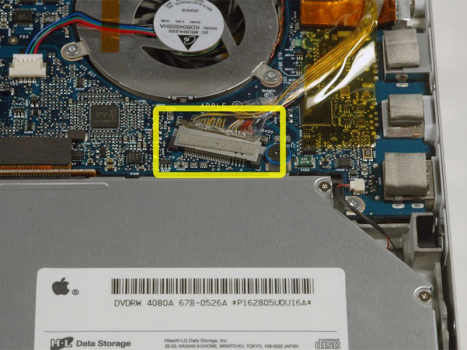Hello,
This is my first time posting in the MacRumors forums, but I have enjoyed reading especially the Early Intel threads! I have an early 2006 MacBook Pro that I got used. There appeared to be display issues, and when I plugged it into a monitor, there was no issue, so I replaced the display but it looks identical. Please see the picture attached. The issue is the exact same as when I originally acquired it. I was wondering if the display I had bought has an issue, or is there a problem with the on-board graphics, in which case I would have to replace the logic board?
Thank you for your time!
View attachment 1853686
I have experienced this very kind of artifacting with one of my laptops, a late 2005 PowerBook G4. For me, it has occurred after reassembling the system after performing a repair or adding in new thermal paste, and the reason has to do with the LVDS display cable being improperly seated where it plugs into the logic board.
Specifically, it’s because (at least in my case) a tiny bit of the yellow kapton tape applied at the factory to hold the display cable in place got caught between the LVDS plug and the board receptacle when I reassembled everything. With the MacBook Pro, there’s a clear, tape-like covering over the LVDS cable, which more or less does the same task of protecting the wires inside and keeping the cable from moving about over time.
Here’s the iFixit close-up of that cable in the PowerBook on which I’ve had this issue:

And here’s iFixit’s close-up of the same cable in your MacBook Pro:

Each time my display looked like this after putting it back together, it’s freaked me out and made me worry that I ruined a critical component. Taking the “don’t panic!” approach, I’ve gone back to inspect everything and made sure anything which
could get in the way is kept
out of the way (such as a tiny bit of overlapping kapton tape or plastic).
Given that you recently acquired this, either the previous owner did some tinkering of their own and ran into a problem like this, or the last repair service did a lousy job of making sure everything was seated properly and not obstructed. If you’re feeling up to opening your system and having a look, here’s
the guide you’ll want to use (and you can skip steps 11–14, after opening the top case, since you’re only in there to inspect and not remove anything). If you see some of that plastic stuck between plug and socket, gently pull out the cable per step 15 and, upon re-inserting it, take care to assure the plastic isn’t getting stuck in between.
There is also the more remote possibility the LVDS cable’s tiny wires may be damaged, but for now, a thorough inspection of where it plugs into the board (including looking inside the receptacle under good lighting and maybe a magnifying glass) is a good first step.
Let us know how it goes.




